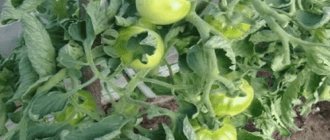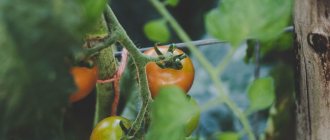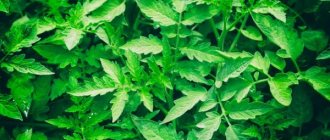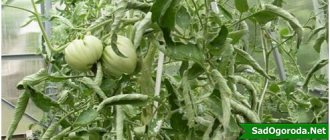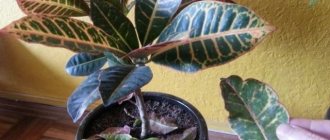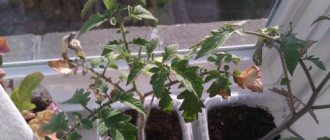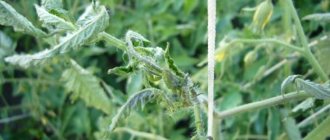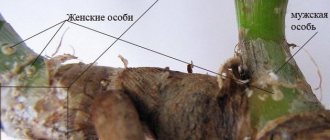The leaves of any plant become indicators of proper care. At the slightest discomfort, they immediately notify you of the problem. This applies not only to indoor flowers, but also tomato seedlings. Under unfavorable conditions, the leaf blades darken, dry out and curl inward or upward (can be seen in the photo). In such cases, help is required so that the plant does not die and produces a good harvest in the future. It is necessary to understand in time why this is happening and take some measures. Let's look at why the leaves on tomatoes are spinning and what to do about it.
Common causes of leaf curling
- Incorrectly selected soil.
- Skipping the stage of seed disinfection before sowing.
- Excess or lack of moisture.
- Low indoor air humidity.
- Growing at elevated temperatures.
- Burn of leaf plates.
- Lack of lighting.
- Diseases as a consequence of violation of the rules of agricultural technology.
- Pest attack.
- Mechanical damage during picking, pinching, transplanting.
Curling leaves of tomatoes of the Honey Drop, Fatima, Japanese crab, and certain types of cherry tomatoes can be considered the norm.
Preventive actions
In order not to repeat mistakes in the future and not get twisted sheet plates, preventive measures should be taken.
Necessary:
- observe conditions suitable for growing seedlings - avoid excessive humidity or dryness, elevated temperatures;
- apply fertilizers in exact accordance with dosages within the prescribed time limits;
- regularly assess the condition of tomato seedlings, treat the plant or get rid of it when the first signs appear;
- do not neglect disinfection, use proven, highly effective fungicides.
Such measures will help maintain the health of the seedlings, and in the future obtain high-quality fruits.
The leaves are spinning down
Imbalance of microelements in the soil
The foliage of tomato seedlings may curl downward due to an imbalance of elements.
- Copper. The lack of this element causes the tips of the leaves and their petioles to droop down. As the situation worsens, tissue necrosis or chlorosis begins.
- Bor. If there is not enough of this element in the soil, then the young leaves of the upper tier begin to curl. A secondary symptom is yellowing of the middle layer.
- Sulfur. Young foliage also suffers, with the subsequent formation of necrotic spots on it.
- Potassium. It is considered the main element for this culture. With its deficiency, the tips curl down, then the plates begin to spin along the entire edge towards the central vein. A secondary symptom is small young leaves.
- Zinc. A deficiency is fraught not only with outward curling, but also with the appearance of brown-gray spots on already formed leaves and yellow spots on young ones.
- Nitrogen. The edges of the leaves not only curl down, but also quickly turn pale, gradually becoming completely yellow.
Both a deficiency and an excess of certain elements are harmful to plants.
- Bor. The tips of the leaves dry out, become brittle and gradually bend down. Defeat comes from the bottom up.
- Zinc. Under the gun - the lower, old foliage. Curl around the entire edge. A secondary symptom is a purple tint on the back of the plates.
Lack of moisture
The older the seedlings, the more moisture they need. Lack of water causes the leaves to curl outward. Defeat comes from the bottom up. A secondary symptom is that the leaves wither.
If in open ground adult plants, due to their long and powerful root system, can absorb water from the deep layers of the soil, then seedlings only form roots and therefore need frequent watering.
The situation is aggravated by growing seedlings in light, loose soil, which causes water to evaporate from the soil very quickly.
Correcting the watering regime will help prevent the problem. On average, this is once every 4-5 days in sunny weather and once every 7-8 days in cloudy weather.
A characteristic sign of lack of moisture is that the leaves not only curl downwards, but also become curly.
Curling of tomato leaves due to lack of moisture is typical for hybrids and varieties with thin leaf blades, which leads to rapid evaporation of moisture.
Proper care of seedlings
The health of seedlings depends on proper care. If all care measures are carried out in accordance with the requirements, the plants will quickly gain strength and take root in a new place without problems when transplanted.
- When sowing a tomato, you first need to disinfect the seeds and soil. In both cases, a solution of potassium permanganate is used.
- The sown seeds are covered with film or glass and put away in a warm place.
- When the first shoots appear, the cover is removed from the containers, and the seedlings themselves are placed in a bright, warm place.
Plants are fertilized every 2 weeks. Mullein infusion diluted with water and complex mineral fertilizers are suitable for this. Feeding can be alternated.
Watering seedlings should be moderate but regular. The seedlings are irrigated with a spray bottle. The grown sprouts are watered with a teaspoon, syringe or pipette directly to each plant or with a watering can without a nozzle along the edge of the container. More mature plants are watered in a tray, this promotes the formation of a strong root system.
The air temperature in the room is first lowered slightly and in the first 7 days it is maintained at 15 degrees during the day and 10 degrees at night. To do this, open the window slightly at night. In the second week, the temperature rises by 4 degrees day and night. This temperature regime is maintained until 3-4 true leaves appear.
Then the temperature for tomatoes should be 20-25 degrees during the day and 16-20 degrees at night. At higher temperatures and increased dry air, the room is ventilated and irrigated using a humidifier or spray bottle once a day.
Daylight hours for seedlings should be 12-14 hours. If the daylight hours are short, the plants are illuminated with a phytolamp in the morning and evening.
Plants should grow in light, but direct sunlight should not touch the leaves, as they can cause sunburn. The light should be diffused.
Planting of seedlings occurs when two true leaves are formed on the plants. The sprouts are planted in individual pots measuring 6 by 6 or 8 by 8 centimeters. Disposable cups, peat pots, cassettes or wide boxes, the height of which should be 15-20 centimeters, are used as containers.
- The soil mixture is poured into the container, the same as when sowing seeds.
- The earth is watered with a warm solution of potassium permanganate.
- After transplantation, the plants are watered after 4-5 days, this allows the plants to take root and not damage the roots.
- After the dive, additional illumination stops for 3-4 days, then resumes.
To protect seedlings from diseases and pests, preventative spraying with chemicals or folk remedies is carried out regularly.
Stepchildren formed on grown plants are carefully cut off. They are removed gradually.
After 20-25 days, the strengthened seedlings are transplanted into larger containers or a greenhouse.
Before planting, the seedlings are hardened off. First, the window opens. When the air temperature outside is 10-12 degrees, containers with tomatoes are taken out for 2-3 hours. After a week, the seedlings are left outside for the whole day and brought indoors or into a greenhouse at night. In hardened plants, the stems turn bluish-purple. When hardening, seedlings are watered abundantly.
Plants must be replanted in a timely manner. The root system should not be stressed. When transplanting seedlings, it is better to use the transshipment method; this protects the plants from technical damage and promotes rapid rooting and growth.
If all growing conditions are met, problems with leaves of tomato seedlings can be avoided. At the same time, the plants develop well and subsequently produce a healthy and abundant harvest.
The leaves are spinning up
Imbalance of microelements in the soil
- Magnesium. The lack of this element in the soil leads to disruption of the turgor of leaf plates and curling of their edges upward towards the central vein. An additional sign is chaotic yellow spots.
- Potassium. The folding of leaves up into a tube with the simultaneous appearance of a brown border is the main sign of a lack of this element.
- Calcium. With a lack of calcium, the leaf blades gradually curl their edges upward towards the midrib. Later, blossom end rot can be diagnosed on the plant.
- Phosphorus. The lack of an element leads to the leaves curling upward and at the same time the plates on the lower side acquire a purple tint.
- Molybdenum. The consumption of the element is insignificant, but if the soil is unbalanced, its lack leads to the edges of the lower leaf plates turning upward and yellow mottling appearing on them.
Excess moisture
Overwatering is very harmful to tomato seedlings. Curling of seedling leaves upward is the first sign of a violation of the watering regime. If the moisture balance is not equalized, not only the upper part of the plant will suffer, but also its roots, which will lead to rot and complete death of the seedlings.
Curling the leaves upward is a protective reaction of the plant. This increases the area of free evaporation.
It is recommended to water the seedlings no more than once a week. If there are problems, watering is completely removed until the top layer of soil dries. If mulch has been laid, it is removed and the ground is loosened.
Elevated temperatures
Regardless of where tomato seedlings are grown, in a room or a greenhouse, the temperature regime must be observed. If the thermometer in the room rises to +25...+27°C, then the plants, especially seedlings, turn on a defense mechanism.
The edges of the seedlings' leaves will first rise upward, and then the leaf blade will curl into a tube. This prevents the evaporation of moisture from the fabrics. A secondary symptom is dropping of the ovaries.
If it is impossible to lower the temperature, then it is necessary to humidify the air around the tomato seedlings, making sure that drops do not fall on the plants. In a greenhouse, daily ventilation is mandatory.
Tips for gardeners
If curling of tomato leaves is not a varietal feature, then you should follow a number of tips for caring for tomato seedlings.
Important:
- do not try to “feed” the seedlings with all available fertilizers;
- do not overdo it with watering, but also do not allow it to dry out;
- gradually harden the seedlings to increase their immunity;
- use plant protection products for preventive and therapeutic purposes.
Whatever the reason for the curling of tomato leaves, you should pay special attention to it. Do not panic and throw away all the plants; it is important to assess the condition of the seedlings and take all measures to improve their condition.
Curling of the upper leaves
The main reason for the curling of the upper leaves of tomato seedlings is an excess of nitrogen. This crop takes feeding well, but most of all it needs potassium and phosphorus. Nitrogenous fertilizers lead to fattening: the stem thickens, the leaf blades increase, and the apical leaves begin to curl into a ring.
The tops of greenhouse tomatoes often begin to twist when the temperature in the greenhouse exceeds the critical +30...+35°C.
Answers to frequently asked questions
Gardeners often ask the following questions related to growing tomato seedlings:
How often to water tomatoes?
It depends on the temperature. But watering is required when the top layer of soil dries out.
Do seedlings need to be fed before planting?
If tomatoes are planted in a nutrient substrate, then the fertilizers in the soil are enough for them. If the seedlings look sickly and weak, then it is worth feeding them. But this can be done no earlier than 7-10 days after germination.
Pests
Whiteflies, aphids and spider mites love seedlings and young tomato plants.
- The whitefly settles on the lower leaves of tomatoes. Curling of the plates, their dryness, fragility and falling off is the third stage of the pest attack. It is preceded by the appearance of sticky whitish spots on the back of the leaf.
- Aphids attack the upper leaves. Having settled on the seedlings, the insect introduces a substance into the plant tissue that causes curling of the leaf plates and deformation of the stem.
- Spider mites cause the leaves to curl into a tube. In addition, the plant is covered with a thin cobweb.
Varietal feature of tomatoes
Sometimes tomato leaves can curl due to the characteristics of a particular tomato variety/hybrid. If the plants do not show any other alarming signs (that is, their foliage is clean and the soil underneath is moderately moist), then there is no need to worry. However, do not stop systematically inspecting the bushes, and if you notice any subtle small spots, then treat the tomatoes with turmeric infusion as a preventive measure.
- Turmeric for treating the garden against diseases
We treat tomatoes and peppers with turmeric to prevent diseases. Will it work?
Diseases
Violation of agricultural practices when growing tomato seedlings causes fungal and bacterial diseases. The pathogen can be identified by external signs.
- Bacteriosis. The reason is the sowing of undisinfected seeds. Signs - young plants lose turgor, their leaves become smaller, the lower leaf plates curl outward.
- Fusarium. A fungal disease that attacks the plant from the bottom up. There is a sharp loss of turgor, the edges of the leaves dry out and curl up.
- Bacterial cancer. Develops at elevated temperatures and high humidity conditions. The leaves only spin upwards. An additional feature is dark bundles of veins on the cut of the petioles.
- Stolbur, or phytoplasmosis. A disease carried by cicadas and bedbugs. Symptom: yellowing and deformation of leaf blades. The leaves along the edges acquire a violet-lilac hue, dry and rise upward, gradually the entire plate takes the shape of a boat.
- Verticillium. A characteristic feature is yellow leaves below and chlorotic curl at the top. The leaves turn very strongly and dry out.
- Tobacco mosaic virus. The main symptom is discoloration and wrinkling of leaves. The plates gradually curl and take on a fern-like shape.
Fever
Incorrect temperature conditions have a very bad effect on tomatoes. In this case, not only the leaves curl, but also the color and ovary are shed.
If tomatoes grow in greenhouse conditions, then the situation can be corrected with the help of ventilation. If the structure does not have windows, then whitewashing the walls or covering them with gauze will help.
When tomatoes are growing in the area, try the following:
- try to shade the bed;
- increase morning and evening watering;
- add nitroamosphosphate diluted with water to the soil, about 20 g of the substance per 1 sq. m.
Afterwards, cover the soil between the rows with hay or agricultural material. For best effect, mulch the ground.
Attention! If you notice that the problem has become widespread, then you need to feed the plants with urea. Take 1.5 tbsp per bucket of water. l. urea and add 1 liter under each bush. solution. After three days, feed the tomatoes with potassium sulfate.
Violation of agricultural technology
Stepsoning
As the tomato bushes grow, side shoots, or stepsons, begin to grow. They must be removed promptly. If this is not done, the bushes will become too branchy and the leaves will not have enough nutrients, causing them to become smaller and curl downward.
There is also a downside to this situation: if you remove many stepsons at once, the plant will react to this by twisting the leaves into a tube and dropping buds.
Transfer
Tomatoes always react to transplantation by losing turgor and curling the edges of the leaves downwards. This condition is considered normal for 2-3 days. If it is more, then we can talk about stress and the addition of a fungal infection.
How to avoid curling
It is not enough to know the reasons why the leaves of tomato seedlings curl. It is important to be able to prevent deviation. Preventive measures are as follows:
Treating seeds before sowing
- Treating containers for planting with disinfectant solutions. Often, gardeners use a medium concentration manganese solution.
- Proper soil preparation. Purchased or prepared substrate is spilled with Fitosporin or potassium permanganate. It is also important to add sand, ash and vermiculite to the soil. With the help of these components, the soil mixture will be light and loose, which is positive for the development of seedlings.
- Treating seeds before sowing. For the procedure, a strong solution of potassium permanganate, fungicides and alcohol-based preparations are used.
- Using a disinfected tool when picking seedlings.
- Compliance with the recommended temperature regime at different stages of seedling development.
- Organization of good drainage and systematic watering. Stagnation of water will provoke root rot, and insufficient moisture disrupts the development of the root system.
- Use of nutritional supplements at the specified times and in the recommended quantities. An excess of minerals also has a detrimental effect on seedlings, as does their deficiency.
The health of seedlings is influenced by many factors. To get strong, viable seedlings, you need to gain experience and be patient. Providing proper care and compliance with cultivation requirements will avoid most problems with tomatoes. If curling does begin, treatment should be started immediately, otherwise the risk of crop loss increases.
Diseases
Adult plants and seedlings may be lost due to various infections. The appearance of an infection can be determined by the rapid development of negative changes in the appearance of plants. It is easy to recognize the name of the disease from photos in specialized Internet articles on gardening sites.
Blackleg
Seedlings are primarily threatened by the common “black leg”, which appears in stuffy, humid and poorly lit environments. The infection can be caused by rot bacteria or molds and is transmitted through soil and untreated seeds.
Infected seedlings do not survive; they sag and then die. The pathogen attacks the roots and stem at the base, cutting off the access of water and nutrients to the top.
Fighting the infection is practically useless. It is better to take preventive measures: disinfect the soil, tools, boxes, ventilate and darken the room.
Bacteriosis
Seedlings become ill with this disease through undisinfected seeds or with the help of insects. Seedlings develop poorly, small leaves turn pale and may curl outward. The flowers lose their bright yellow color, becoming whitish. The fruits stop forming. Tomatoes are uprooted and destroyed, and the soil is disinfected.
Fusarium wilt
A fungal disease spreads through soil microflora. It crawls along the seedling from bottom to top, first the edges of the lower leaves turn yellow, then the higher ones. Plants cannot be treated; they are destroyed, and the soil in the greenhouse is spilled with a solution of potassium permanganate.
Bacterial canker of tomato
A very dangerous disease that a vegetable can become infected with at any period of development. Most often, the infection appears already at the stage of 1-3 true leaves. The bacterium is transmitted through soil, seeds, and tools. Small whitish spots appear on the plants, then turn yellow around the edges and curl. Due to damage to the vascular system, the tomato wilts.
It is impossible to fight cancer; seedlings are immediately removed. You can prevent its occurrence by warming the seeds before planting.
Thin leaf virus
Sometimes found in hot spring under strong light. The infection is imported into the country with Dutch seeds that have not been treated with antiviral agents. It cannot be treated, and the infected plant does not bear fruit.
Yellow curl of tomato leaves
Carried by whiteflies. In appearance, this viral disease can easily be confused with chlorosis, deficiency of phosphorus, iron, magnesium, and yellowness of the apex. If infected early, the plant grows poorly and does not set fruit. A diseased tomato bushes heavily, the leaves curl and turn yellow. The tomato must be destroyed immediately.
It is not always possible to answer the question: why seedlings are affected by a fungal pathogen. After all, the infection could have entered the plantings with the wind, soil, insects, and seeds.
Sources
- Gavrish S.F. Tomatoes // M.: NIIIOZG, LLC “Publishing House Scriptorium 2000”, 2003 – 184 p.
- Polyanskaya A.M. and a team of authors. Advice for gardeners // Minsk, publishing house “Urozhay”, 1970 – 208 p.
- Grebenshchikov S.K. Reference manual on plant protection for gardeners and gardeners // M.: Agropromizdat, 1991 – 208 p.
- State catalog of pesticides and agrochemicals approved for use on the territory of the Russian Federation as of July 6, 2022 // Ministry of Agriculture of the Russian Federation. https://mcx.gov.ru/ministry/departments/departament-rastenievodstva-mekhanizatsii-khimizatsii-i-zashchity-rasteniy/industry-information/info-gosudarstvennaya-usluga-po-gosudarstvennoy-registratsii-pestitsidov-i-agrokhimikatov/
Mechanical damage
The tomato is not only not afraid of injury to the root system, but even loves transplanting, deepening and hilling. All these actions allow you to grow additional lateral roots that grow directly from the bottom of the stem.
However, damage to the fibrous suction roots during weeding or hilling will negatively affect the development of the plant, delaying the date of fruiting. Seedlings may even wither, which can be easily corrected by watering and hilling.
Treatment
First of all, you should determine the cause of leaf curling. If the deformation is caused by maintenance errors, adjust watering, temperature, and pinching.
With excess nitrogen:
- exclude nitrates from the tomato diet;
- water the bushes well to flush out nitrogen;
- outside the plan they provide phosphorus and potassium.
It is necessary to feed the tomato with fertilizers, which are in short supply. It is better to give microelements in combination. Spray the above-ground part with chelates, adding epin to strengthen the immune system.
It is recommended to give copper separately. Its deficiency leads to the development of late blight. Preparations containing the element do not combine well with other chemical or biological agents.
If viral diseases or bacterial cancer are detected, the bush is destroyed. Pests that carry infections are controlled using appropriate insecticides.
Variety
If the sprouts have formed correctly and have the usual shade, and you have not noticed any other diseases or abnormalities, then perhaps this is simply a feature of your tomatoes. Take a close look at the plantings, if the sprout on the seedlings is slightly lowered and barely curled down - this is a characteristic sign of the variety. The following varieties have these traits: Cherry, Fatima and Honey Drop.
Very rugged leaf, may be characteristic of tall varieties. Long and tall types of tomatoes have voluminous leaves that hang down and can curl slightly. Before purchasing different types of tomatoes, you need to consult a seed seller to find out what characteristics these particular types of tomatoes have and what they will look like.
Nutrient deficiencies
A deficiency can occur if the bushes are not fed once every two weeks. Especially in greenhouses, it warms up quickly, but the soil does not. In this case, the plant cannot accumulate nutrients. Thus, tomato leaves curl down and change color, and the vein in the center of the leaf becomes convex and rough:
- if there is a lack of phosphorus, the leaves acquire a red-violet hue;
- if there is a lack of zinc, the leaves bend down, the tops curl, especially in seedlings;
- with a lack of boron, young leaves curl;
- deficiency of copper and sulfur - shoots are crushed;
- calcium deficiency - leaves curl and become pale;
- With a lack of iron, the leaves turn yellow and begin to droop.
You can correct the situation by feeding. It is good to spray the plant with a solution of immunomodulators, zircon, when the weather is hot, in rainy and cool weather - Epin, Mortar - used for general fertilizing.
Start taking care of your tomatoes at the seedling stage, this will help avoid problems in the future and bring you a worthy reward in the form of a good harvest.
pomidorchik.com

